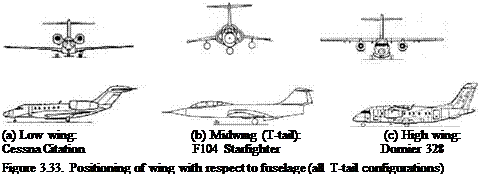Wing Taper Ratio, X
This is defined as the ratio of the wing tip chord to the wing root chord (ctip/croot). The best taper ratio is in the range from 0.3 to 0.6. The taper ratio improves the wing efficiency by giving a higher Oswald’s efficiency factor (see Section 3.10).
3.16.6
 |
Wing Twist
The wing can be twisted by making the wing tip nose down (i. e., washout) relative to the wing root (Figure 3.32), which causes the wing root to stall earlier (i. e., retain aileron effectiveness). Typically, a 1- to 2-deg washout twist is sufficient. Twisting the wing tip upward is known as washin.
3.16.7 High/LowWing
Depending on the design drivers, an aircraft configuration can place the wing anywhere from the top (i. e., high wing) to the bottom (i. e., low wing) of the fuselage or in between (i. e., midwing), as shown in Figure 3.33. Structural considerations of the wing attachment to the fuselage comprise a strong design driver, although in the civil aircraft market, the choice could be dictated by customer preference. The wing center section should not interfere with the cabin passage-height clearance – especially critical for smaller aircraft. A fairing is shown for low-wing aircraft (Figure 3.33a, Cessna Citation) or high-wing aircraft (Figure 3.33c, Dornier 328), where the wing passes under or over the fuselage, respectively. Both cases have a generous fairing that conceals the fuselage mould-line kink (i. e., drag-reduction measure), which would otherwise be visible. Midwing (or near-midwing) designs are more appropriate to larger aircraft with a passenger cabin floorboard high enough to allow the wing box positioned underneath it.
 |
Aircraft with a high wing allow better ground clearance (see Figures 3.33c and 3.49) and the fuselage to be closer to the ground, which makes cargo-loading easier – especially with a rear-fuselage cargo door. Turboprops favor a high-wing configuration to allow sufficient ground clearance for the propeller. The main undercarriage is mounted on the fuselage sides with the bulbous fairing causing some additional drag. However, this configuration provides better aerodynamics (e. g., the BAe RJ100 and Dornier 328 are successful high-wing designs). The dominant configuration for civil transport aircraft has been a low wing, which provides a wider
|
|
main-undercarriage wheel track (see Chapter 7), allowing better ground maneuvering. A low wing also offers a better crashworthy safety feature in the extremely rare emergency situation of a belly landing. However, the author believes more high-winged, large commercial transport aircraft could be developed. Design trends shows that military transport aircraft have predominantly high wings with large rear- mounted cargo doors.












